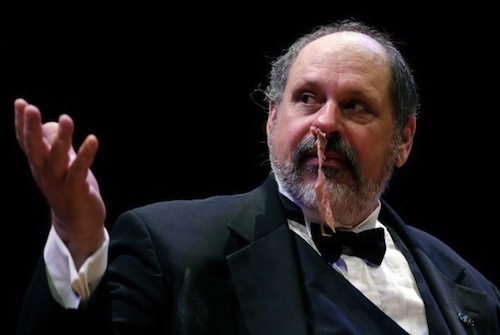“Emilie” and the theater of science
“Emilie: La Marquise du Châtelet Defends Her Life Tonight” at Central Square Theater gets at the heart of the science/theater conundrum better than any play I’ve seen so far.
I was on the board of Underground Railway Theatre (one of the two companies operating out of Central Square Theater) and we struggled, sometimes, with what a play about science is, and what audiences are expecting and will accept. “Emilie”–sorry, that full title is a freaking albatross and I don’t know what the playwright or her initial producers were thinking–is in many ways a classic “science play,” that is, the biography of a particular scientist. In this case, Emilie du Chatelet, a French mathematician and physicist who was the mistress of Voltaire, among others. Emilie was one of life’s great winners, an energetic woman whose social rank allowed her a vast amount of privilege and the ability to spend her time as she would.

“Having it all,” Enlightenment style. (Lee Mikeska Gardner and Steven Barkhimer. Photo by A.R. Sinclair Photography)
What excited me about the play, though, was the underlying theme of the relationship–the correct relationship–between science and theater. Emilie is a scientist, and her lover Voltaire a playwright, and theater and hard science are frequently compared by her, during their arguments, to the disadvantage of theater. Science is about finding out the truth, Emilie implies, while drama is about creating what you want to see. Playwrights invent, actors lie, but scientists discover.
Except scientists have to do more than discover, don’t they?
Without the demonstration, no one else can understand the discovery. If no one else understands the discovery, it doesn’t become part of the canon. If it doesn’t become part of the canon, it doesn’t help guide other people’s discoveries.
Discovery without demonstration is a solo epiphany.
Discovery with demonstration is science.
Science needs theater.
If “Emilie” has anything as simple as a moral, it is that uncovered truth must be transmitted–demonstrated–to other people in order to reach its full worth. Emilie comes to realize that drama and science, like love and philosophy, are not opposed, but are necessary complements.
We put on the Ig Nobel Prize ceremony the day after I saw “Emilie,” and that is all about the theater of science, although our demonstrations of prize-winning articles and inventions are usually called off at the last minute by our onstage V-Chip Monitor. This year, the Medicine Prize went to Ian Humphreys, Sonal Saraiya, Walter Belenky and James Dworkin, for treating “uncontrollable” nosebleeds, using the method of nasal-packing-with-strips-of-cured-pork. Here is our distinguished Major Domo, Gary Dryfoos, gamely stuffing bacon up his nose by way of demonstration. Science isn’t always as sexy as Emilie.
Robin Abrahams's Blog




